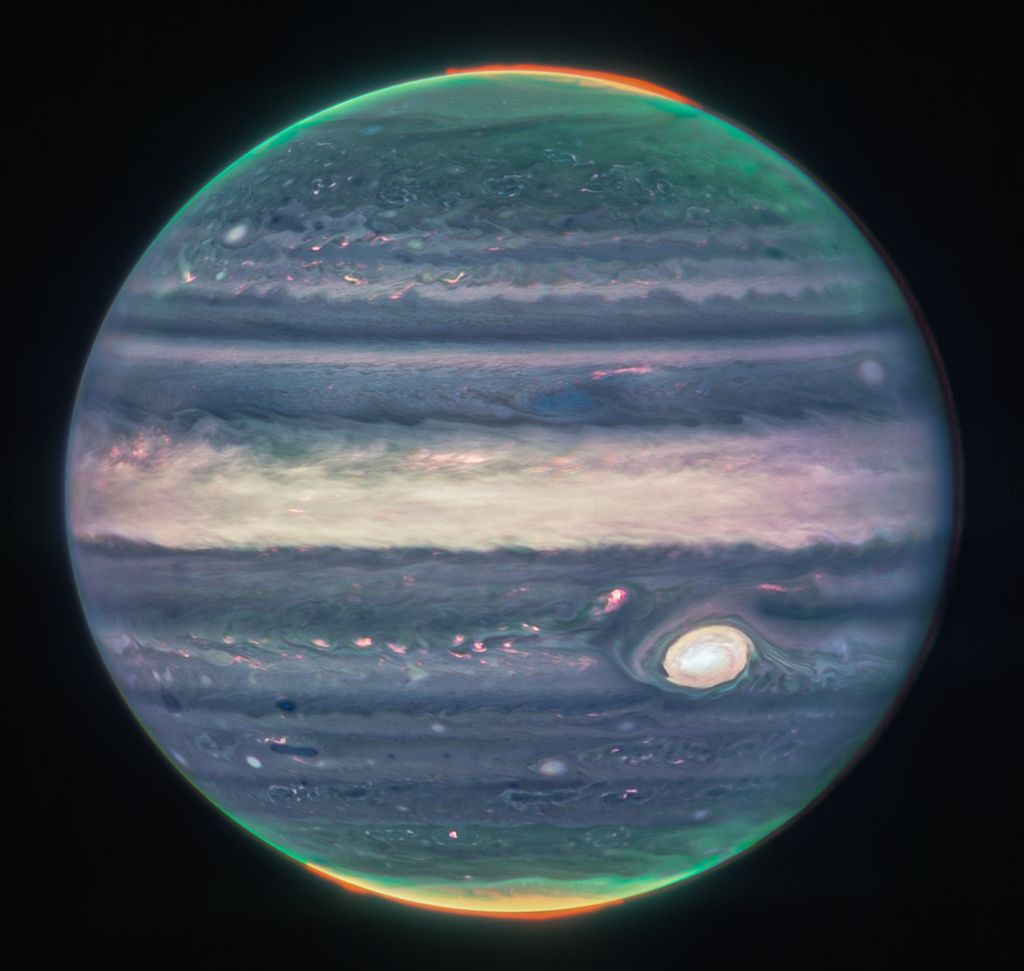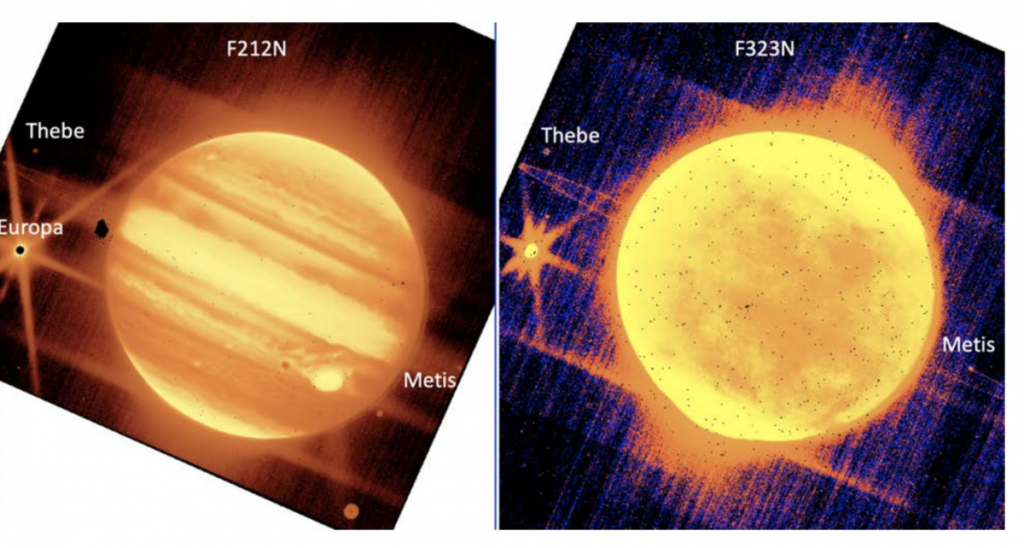
JWST’s Incredible New Images Of Jupiter
It has been almost 9 months since the James Webb Space Telescope was launched in December last year. During this time the telescope has completed a long list of different tasks and recently released some of its first images. Since then, Webb has continued to provide fascinating photos and data on different aspects of the Universe. All of which scientists continue to point out is better than expected.
Most recently, NASA released some new images that highlight auroras on Jupiter. The agency highlights that Jupiter features giant storms, powerful winds, auroras, and extreme temperature and pressure conditions. Webb’s Jupiter observations will give scientists even more clues to Jupiter’s inner life, including the images just released.
Webb is by far the most advanced space telescope sent into space. While it took billions of dollars and decades of work, the observatory is finally paying off with consistent science operations and results. These images are just another great example of what is capable with Webb. Here I will go more in-depth into the recent images, what exactly they depict, and what to expect in the future from the JWST.
New Images

Just yesterday NASA tweeted saying, “Make way for the king of the solar system! New Webb images of Jupiter highlight the planet’s features, including its turbulent Great Red Spot, in amazing detail. These images were processed by citizen scientist Judy Schmidt. This included one of the images taken that clearly shows a unique perspective on Jupiter. Many scientists were quite surprised after seeing the images. “We hadn’t really expected it to be this good, to be honest,” said planetary astronomer Imke de Pater, professor emerita of the University of California, Berkeley. De Pater led the observations of Jupiter with Thierry Fouchet, a professor at the Paris Observatory, as part of an international collaboration for Webb’s Early Release Science program. Webb itself is an international mission led by NASA with its partners ESA (European Space Agency) and CSA (Canadian Space Agency). “It’s really remarkable that we can see details on Jupiter together with its rings, tiny satellites, and even galaxies in one image,” she said.
In addition to this image, Webb captured another which showed off additional features. Specifically, NASA also tweeted yesterday mentioning, “Check out the bright waves, swirls, and vortices in Jupiter’s atmosphere — as well as the dark ring system, one million times fainter than the planet! Two moons of Jupiter, including one that’s only about 12 miles (20 km) across, are on the left.” The two images come from the observatory’s Near-Infrared Camera (NIRCam), which has three specialized infrared filters that showcase details of the planet. Since infrared light is invisible to the human eye, the light has been mapped onto the visible spectrum. Generally, the longest wavelengths appear redder and the shortest wavelengths are shown as more blue. Scientists collaborated with citizen scientist Judy Schmidt to translate the Webb data into images.
In the standalone view of Jupiter, created from a composite of several images from Webb, auroras extend to high altitudes above both the northern and southern poles of Jupiter. The auroras shine in a filter that is mapped to redder colors, which also highlights light reflected from lower clouds and upper hazes. A different filter, mapped to yellows and greens, shows hazes swirling around the northern and southern poles. A third filter, mapped to blues, showcases light that is reflected from a deeper main cloud. The Great Red Spot, a famous storm so big it could swallow Earth, appears white in these views, as do other clouds, because they are reflecting a lot of sunlight. “The brightness here indicates high altitude – so the Great Red Spot has high-altitude hazes, as does the equatorial region,” said Heidi Hammel, Webb interdisciplinary scientist for solar system observations and vice president for science at AURA. “The numerous bright white ‘spots’ and ‘streaks’ are likely very high-altitude cloud tops of condensed convective storms.” By contrast, dark ribbons north of the equatorial region have little cloud cover.
In a wide-field view, Webb sees Jupiter with its faint rings, which are a million times fainter than the planet, and two tiny moons called Amalthea and Adrastea. The fuzzy spots in the lower background are likely galaxies “photobombing” this Jovian view. “This one image sums up the science of our Jupiter system program, which studies the dynamics and chemistry of Jupiter itself, its rings, and its satellite system,” Fouchet said. Researchers have already begun analyzing Webb data to get new science results about our solar system’s largest planet. Data from telescopes like Webb doesn’t arrive on Earth neatly packaged. Instead, it contains information about the brightness of the light on Webb’s detectors. This information arrives at the Space Telescope Science Institute (STScI), Webb’s mission and science operations center, as raw data. STScI processes the data into calibrated files for scientific analysis and delivers it to the Mikulski Archive for Space Telescopes for dissemination. Scientists then translate that information into images like these during the course of their research. While a team at STScI formally processes Webb images for official release, non-professional astronomers known as citizen scientists often dive into the public data archive to retrieve and process images, too.
Judy Schmidt of Modesto California, a longtime image processor in the citizen science community, processed these new views of Jupiter. For the image that includes the tiny satellites, she collaborated with Ricardo Hueso, a co-investigator on these observations, who studies planetary atmospheres at the University of the Basque Country in Spain. Jupiter is actually harder to work with than more distant cosmic wonders, Schmidt says, because of how fast it rotates. Combining a stack of images into one view can be challenging when Jupiter’s distinctive features have rotated during the time that the images were taken and are no longer aligned. Sometimes she has to digitally make adjustments to stack the images in a way that makes sense. Webb will deliver observations about every phase of cosmic history, but if Schmidt had to pick one thing to be excited about, it would be more Webb views of star-forming regions. In particular, she is fascinated by young stars that produce powerful jets in small nebula patches called Herbig–Haro objects. “I’m really looking forward to seeing these weird and wonderful baby stars blowing holes into nebulas,” she said.
First Jupiter Images

Back in July, NASA released some of the first images Webb had taken of Jupiter. In these images, you could recognize some familiar features of our solar system’s enormous planet through Webb’s infrared gaze. A view from the NIRCam instrument’s short-wavelength filter shows distinct bands that encircle the planet as well as the Great Red Spot, a storm big enough to swallow the Earth. The iconic spot appears white in this image because of the way Webb’s infrared image was processed. “Combined with the deep field images released the other day, these images of Jupiter demonstrate the full grasp of what Webb can observe, from the faintest, most distant observable galaxies to planets in our own cosmic backyard that you can see with the naked eye from your actual backyard,” said Bryan Holler, a scientist at the Space Telescope Science Institute in Baltimore, who helped plan these observations.
Clearly visible at left is Europa, a moon with a probable ocean below its thick icy crust, and the target of NASA’s forthcoming Europa Clipper mission. What’s more, Europa’s shadow can be seen to the left of the Great Red Spot. Other visible moons in these images include Thebe and Metis. “I couldn’t believe that we saw everything so clearly, and how bright they were,” said Stefanie Milam, Webb’s deputy project scientist for planetary science based at NASA’s Goddard Space Flight Center in Greenbelt, Maryland. “It’s really exciting to think of the capability and opportunity that we have for observing these kinds of objects in our solar system.” Scientists were especially eager to see these images because they are proof that Webb can observe the satellites and rings near bright solar system objects such as Jupiter, Saturn, and Mars. Scientists will use Webb to explore the tantalizing question of whether we can see plumes of material spewing out of moons like Europa and Saturn’s moon Enceladus. Webb may be able to see the signatures of plumes depositing material on the surface on Europa. “I think that’s just one of the coolest things that we’ll be able to do with this telescope in the solar system,” Milam said. All of which have been captured in a short period of time by Webb.
Conclusion
The James Webb Space Telescope is proving to be a very successful instrument in space. For weeks now the telescope has been performing consistent science operations and providing incredible images and data. We will have to wait and see how it progresses and the impact it has on the space industry.
